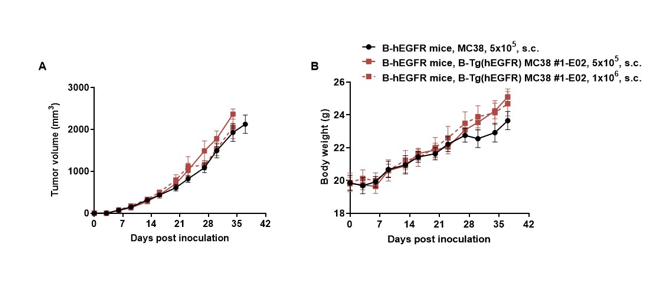Common name
|
B-Tg(hEGFR) MC38
|
Catalog number
|
322295
|
|
Aliases
|
EGFR, ERBB, ERBB1, ERRP, HER1, NISBD2,
PIG61, mENA, epidermal growth factor receptor
|
Disease
|
Colon carcinoma
|
Organism
|
Mouse
|
Strain
|
C57BL/6
|
|
Tissue types
|
Colon
|
Tissue
|
Colon
|
Description
The expression cassette containing an exogenous promoter, the extracellular region of human EGFR, and the transmembrane and intracellular regions of mouse EGFR was randomly inserted into the genome of B-Tg(hEGFR) MC38 cells. Humanized EGFR was detected to be highly expressed on the surface of B-Tg(hEGFR) MC38 cells.
Application
B-Tg(hEGFR) MC38 cells have the capability to establish tumors in vivo and can be used for efficacy studies.
Targeting strategy
Gene targeting strategy for B-Tg(hEGFR) MC38 cells. The expression cassette containing an exogenous promoter, the extracellular region of human EGFR, and the transmembrane and intracellular regions of mouse EGFR was randomly inserted into the genome of B-Tg(hEGFR) MC38 cells.
Protein expression analysis
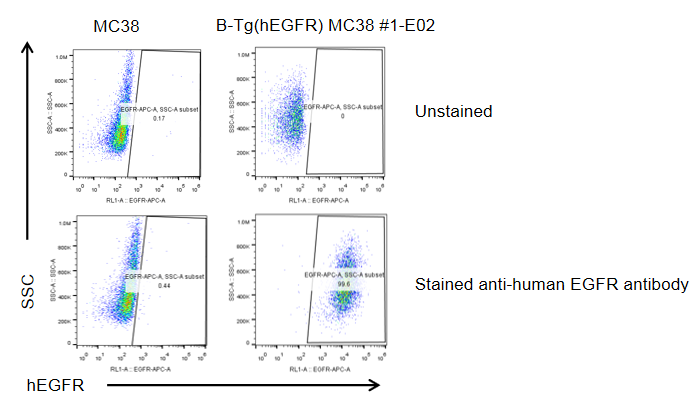
EGFR expression analysis in B-Tg(hEGFR) MC38 cells by flow cytometry. Single cell suspensions from wild-type MC38 and B-Tg(hEGFR) MC38 cultures were stained with species-specific anti-EGFR antibody. Human EGFR was detected on the surface of B-Tg(hEGFR) MC38 cells but not wild-type MC38 cells. The 1-E02 clone of B-Tg(hEGFR) MC38 cells was used for in vivo tumor growth assays.
Tumor growth curve & Body weight changes
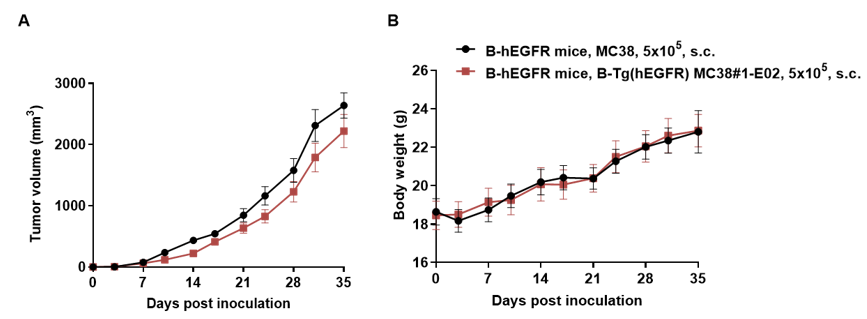
Subcutaneous homograft tumor growth of B-Tg(hEGFR) MC38 cells. B-Tg(hEGFR) MC38 cells (5x105) and wild-type MC38 cells (5x105) were subcutaneously implanted into homozygous B-hEGFR mice (female, 6-9-week-old, n=6). Tumor volume and body weight were measured twice a week. (A) Average tumor volume ± SEM. (B) Body weight (Mean ± SEM). Volume was expressed in mm3 using the formula: V=0.5 X long diameter X short diameter2. As shown in panel A, B-Tg(hEGFR) MC38 cells were able to form tumors in vivo and can be used for efficacy studies.
Tumor growth curve of individual mice
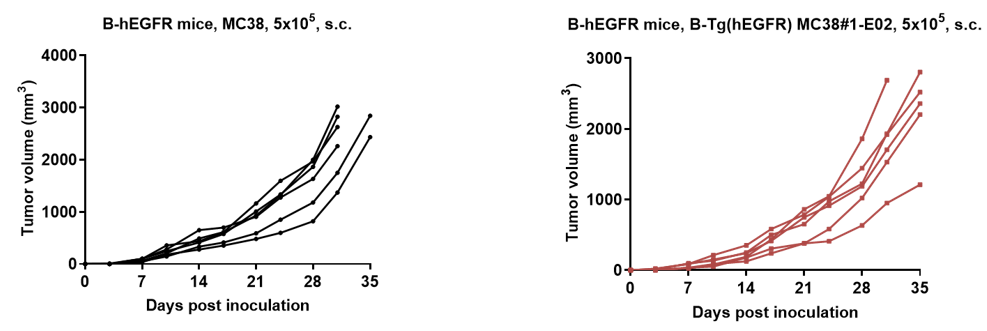
B-Tg(hEGFR) MC38 tumor cells growth of individual mice. B-Tg(hEGFR) MC38 cells (5x105) and wild-type MC38 cells (5x105) were subcutaneously implanted into homozygous B-hEGFR mice (female, 6-9-week-old, n=6). As shown in panel, B-Tg(hEGFR) MC38 cells were able to establish tumors in vivo and can be used for efficacy studies.
Protein expression analysis of tumor cells
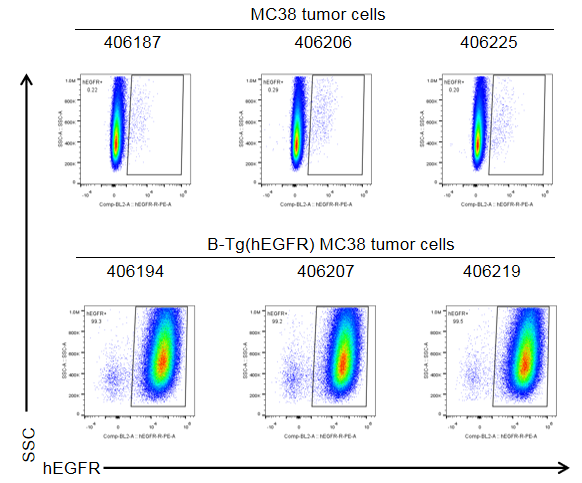
B-Tg(hEGFR) MC38 cells were subcutaneously transplanted into homozygous B-hEGFR mice (n=6), and on 35 days post inoculation, tumor cells were harvested and assessed for human EGFR expression by flow cytometry. As shown, human EGFR was highly expressed on the surface of tumor cells. Therefore, B-Tg(hEGFR) MC38 cells can be used for in vivo efficacy studies of EGFR therapeutics.
Tumor growth curve & Body weight changes
Subcutaneous homograft tumor growth of B-Tg(hEGFR) MC38 cells.
B-Tg(hEGFR) MC38 cells (5x105, 1x106) and wild-type MC38 cells (5x105) were subcutaneously implanted into homozygous B-hEGFR mice (female, 5-8-week-old, n=6). Tumor volume and body weight were measured twice a week. (A) Average tumor volume ± SEM. (B) Body weight (Mean ± SEM). Volume was expressed in mm3 using the formula: V=0.5 X long diameter X short diameter2. As shown in panel A, B-Tg(hEGFR) MC38 cells were able to form tumors in vivo and can be used for efficacy studies.
Tumor growth curve of individual mice
B-Tg(hEGFR) MC38 tumor cells growth of individual mice.
B-Tg(hEGFR) MC38 cells (5x105, 1x106) and wild-type MC38 cells (5x105) were subcutaneously implanted into homozygous B-hEGFR mice (female, 5-8-week-old, n=6). As shown in panel, B-Tg(hEGFR) MC38 cells were able to establish tumors in vivo and can be used for efficacy studies.




